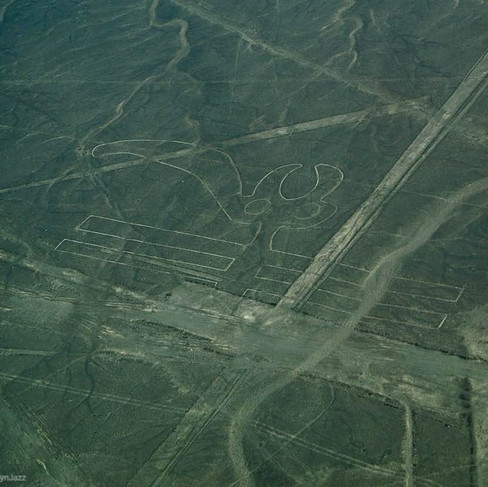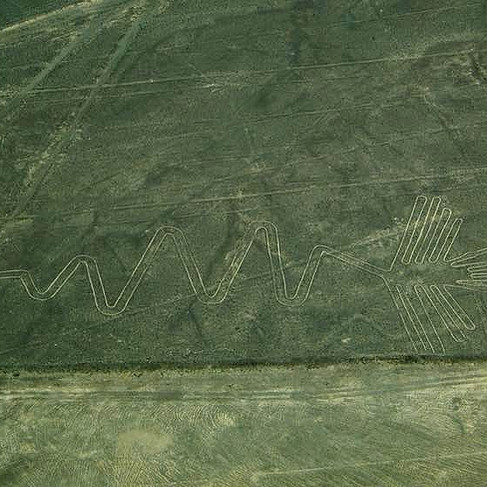Flying Over Nazca, Peru
- Lyn (aka Jazz)
- Nov 27, 2023
- 7 min read
Imagine a desert landscape adorned with giant figures and lines, so massive they can only truly be appreciated from high above. The Nazca Lines, a UNESCO World Heritage Site, are a mysterious mosaic of figures and lines etched into the arid plains of Nazca, Peru. From the iconic hummingbird to the enigmatic astronaut, these geoglyphs have fascinated historians, archaeologists, and curious minds alike.
My fascination with the Nazca Lines traces back to the days when I eagerly devoured Nancy Drew mysteries as a child. "The Clue in the Crossword Cypher" ignited my determination to see this mysterious place. I knew that my Peruvian adventure would include a visit to these colossal drawings in the Peruvian sand. The thrill of solving mysteries, combined with a love for exploring ancient cultures, made the Nazca Lines a must-see on my travel bucket list.

So, join me on this virtual journey as we unravel the history of the Nazca Lines, exploring their significance, delving into theories behind their creation, and experiencing the magic that unfolds when soaring over these sand etchings in a small plane.
Transportation Options from Lima to Nazca Peru
Nazca is located about 450 km south of Lima. The most efficient and expensive way to travel to Nazca from Lima would be a flight. LATAM and other domestic airlines offer daily flights. Several tour companies also offer charter flights between Lima and Nazca.
I highly recommend the Peru Hop service for travellers on a tighter budget or those preferring slower travel. Having used their Lima to Cusco route (see Lima to Cusco with Peru Hop). I can recommend their reliable and comfortable service, and the opportunities to meet fellow travellers, and hear local stories while soaking in the breathtaking landscapes and slowly adjusting to the elevation I would be experiencing once I arrived in the mountains.
Before arriving in Nazca, I already had a taste of what Ica province had to offer. Paracas and the surreal oasis of Huacachina had left me awestruck. But the Nazca Lines were calling, and I couldn't resist the allure of the desert drawings. I marvelled at the diversity of Peru's geography. The vast desert plains, the whispering winds, and the distant promise of ancient wonders fueled my excitement.

For me, a day trip from Huacachina to Nazca was the perfect plan. I arranged for a flight with AeroNasca over the lines while the efficient Peru Hop guides organized the transportation between Huacachina and Nazca.
Unfortunately, as I arrived at the little airport there was quite a bit of cloud cover so no flights were leaving. It was anticipated that the skies would clear by early afternoon, so I made the decision to wait and I am very glad that I did. I was in the air by 14:00.
The airport is a regional airport serving small planes. Each flight will include a pilot, guide and 4-6 passengers. The airport itself is a giant waiting room with multiple small plane operators but little else of interest. Outside, is a small market place which I had more than enough time to fully explore. As eager as I was to get up in the air, I knew I had to be patient for safety reasons.
The History and Mystery of Nazca
The Nazca Valley is a desert with a strip of very fertile agricultural land, thanks to the aqueducts and aquifers designed by the Nazca people. It is a rocky desert with a surface of red iron-oxide stones.

The Nazca people, predecessors to the Inca, lived in this area from about 500 BCE to 500 CE. They etched these intricate figures and lines into the desert. There are many theories about the methods used, ranging from simple tools to sophisticated surveying techniques. It is mind-boggling to think that these lines have survived for so long in the open desert.
There are also many theories about the purpose, ceremonies and rituals that might have involved these massive etchings. Some researchers suggest the lines have astronomical or agricultural significance, as some lines and figures are aligned with celestial and seasonal events crucial to Nazca life. Others believe they were an offering to the gods, visible only from high above, a sacred message etched into the Earth itself.
The most accepted theory is that both of these are true with the figures being seen as important for the rituals and ceremonies and the lines and trapezoid shapes were used to align with sun and moon cycles and as directional markers for Nazca travellers.
Tips for Small Plane Adventures
The small planes used for Nazca flights are compact, ensuring everyone gets a front-row seat to the spectacle below. The flights are typically smooth, but be ready for a few bumps as the plane adjusts to air currents. The bobbing of the plane as it banks and turns may feel dramatic for those who are inexperienced with small planes but are perfectly normal. The journey is short but packs a punch of awe, so brace yourself for a whirlwind of emotions.
Don't worry about which side of the plane you choose to sit as the pilot follows a route that makes sure that the figures can be seen from both sides of the plane.

The Most Iconic Petroglyphs
With the Nazca Lines stretching beneath me like ancient whispers etched into the desert, the small plane soared over figures that have captivated imaginations for centuries. Each petroglyph held a cultural significance and a tale that begged to be heard.
The Nazca Lines consist of over 800 straight lines, 300 geometric figures, and more than 70 plant and animal designs. The total number of geoglyphs is likely to be significantly higher, but a precise count remains elusive due to the rugged and expansive nature of the desert terrain. Your flight will fly over a small portion.
Spider: Weaver of Tales
The first figure was the spider -- the symbol of fertility and abundance. The Nazca people were deeply connected to the rhythms of nature and saw the spider as a guardian of prosperity. Its eight delicate legs were precisely designed with matching dimensions and curves. I was eager to learn more and had lots of questions for the guide.

Astronaut: Beyond Earthly Boundaries
The guide pointed out the enigmatic Astronaut, a figure seemingly out of place in ancient drawings. He chuckled as he urged us to enjoy the myth of an interstellar visitor but admitted that it is much more likely that this figure represents a shaman or chief.

Monkey: A Playful Presence
The monkey, with its mischievous grin and playful posture, shows the Nazca people's appreciation for the lighthearted moments in life. The monkey was the symbol of fun, laughter, and friends.

Dog: Loyal Guardian of the Nazca Desert
The loyal dog, a symbol of companionship and protection, served as a guardian spirit, watching over the desert and those who crossed its vast expanses.

Hummingbird: Wings of Grace
The hummingbird with its intricate wings symbolized agility, grace, and the fleeting beauty of life.

Condor: The Majestic Soarer
The condor, a symbol of power and freedom, holds a special place in Nazca mythology, embodying the spirit of the sky. The Nazca people immortalized this majestic creature in many of their rituals, drawings, statues, and daily objects. Later, the Aztecs also adopted the Condor into their beliefs.

Heron and Parrot: Winged Wonders
The heron and parrot, though distinct in form, shared a common theme of avian elegance. The parrot celebrated the diversity of life and the heron symbolized balance and adaptability.
Tree: Roots in the Desert Sands
The Tree is part of a trio of geoglyphs that also include the Hand and the Sword. The tree, an unexpected sight in the arid landscape, carried the profound symbolism of an oasis of life amid the desert. The tree represented resilience, growth, and the ability to thrive against all odds.

I was quite shocked to see a highway running right through the Sword figure. The guide explained that this was part of the Pan-American Highway and was built during a time when the ancient geoglyphs were not a consideration. A grand highway connecting the Americas was considered much more important. That highway does allow tourists to see three geoglyphs at ground level for free or pay a modest fee to climb a very rickety metal staircase to a viewing platform for a wider view of the Tree, Hands, and Sword.

The Tree figure is too large to see in its entirety from the platform but the platform is a way to see a hint of the figures and to get a real sense of the true size and construction of these petroglyphs.

At ground level, the simple brilliance of the construction can be appreciated in a way that isn't apparent from above. The lines are shallow trenches where the red desert rock was removed, revealing lighter-coloured base soil. Even after two thousand years, these trenches remain clear.
Hand: The Mark of Humanity
The plane banked to reveal the colossal hand with fingers outstretched. The hand is often interpreted as a symbol of unity and communal effort.

The Hand and the Sword (which is bisected by the highway) can also be viewed from the platform.

Lines and Shapes
The desert not only holds incredible geoglyphs but visitors will also see many lines and trapezoid figures criss-crossing the surface. Some lines appear to align with celestial events such as summer and winter solstice whereas the shapes are believed to point the way to ancient Nazca settlements.

Waterways and Wonders: The Nazca Aqueducts
The flight I chose included flying over the Nazca Aqueducts -- a marvel of ancient engineering. The Nazca Aqueducts, often overshadowed by the grandeur of the lines, were very impressive.

The aqueducts are a network of subterranean and aboveground canals that played a crucial role in supporting agriculture, allowing the Nazca to cultivate the desert and flourish. The intricate channels use gravity to bring water from the Andes. Deep spiral wells gathered the sparse precipitation and connected to deep underground streams.

The water management system created by the Nazca was ingenious and served the community well. In modern times, most farmers are now connected to the public water system but there are a few smaller operations that continue to use the irrigation channels.
Final Thoughts
As the small plane gently touched down, bringing me back to the solid embrace of the Nazca desert, I knew I had enjoyed a grand Nazca adventure. I loved soaring over the lines and thoroughly enjoyed learning more about the Nazca culture. From the spider's delicate legs to the majestic wings of the condor, each geoglyph held a story etched into the desert floor. The little girl who devoured Nancy Drew mysteries was thrilled and the grown-up woman was full of awe and wonder.
If you are enjoying the content and would like to be kept up to date with new posts become a member/subscribe (it's free!) and follow along on the RamblynJazz Facebook page, Facebook Group, Twitter, and Instagram. You can help the blog to grow by sharing the link with a travelling friend or through social media. I truly appreciate your comments and encourage you to share your thoughts below.







